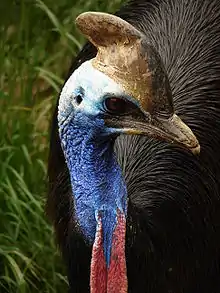Casuariidae
The bird family Casuariidae /kæsjuːəˈraɪ.ɪdiː/ has four surviving members: the three species of cassowary and the emu.
| Casuariidae | |
|---|---|
 | |
| Southern cassowary | |
| Scientific classification | |
| Kingdom: | Animalia |
| Phylum: | Chordata |
| Class: | Aves |
| Order: | Casuariiformes |
| Family: | Casuariidae Kaup, 1847[1] |
| Genera | |
| Diversity | |
| 2-3 genera, 6-7 species | |
All living members of the family are very large flightless birds native to Australia-New Guinea.[2] The characteristics of the family are those of its members.
Species
- † Emuarius Boles, 1992 (emuwaries) (Late Oligocene – Late Miocene)
- † E. gidju (Patterson & Rich 1987) Boles, 1992
- † E. guljaruba Boles, 2001
- Casuarius Brisson, 1760 (cassowary)
- † C. lydekkeri Rothschild, 1911 (Pygmy cassowary)
- C. casuarius (Linnaeus, 1758) (Southern cassowary)
- C. unappendiculatus Blyth, 1860 (Northern cassowary)
- C. bennetti Gould, 1857 (Dwarf Cassowary)
- C. b. westermanni (Sclater, 1874) (Papuan dwarf cassowary)
- C. b. bennetti Gould, 1857 (Bennett's cassowary)
- Dromaius Vieillot, 1816 (emu)
- D. novaehollandiae (Latham, 1790) (Emu)
- † D. n. diemenensis Le Souef, 1907 (Tasmanian emu)
- † D. n. minor Spencer, 1906 (King Island emu)
- † D. n. baudinianus Parker, SA, 1984 (Kangaroo Island emu)
Systematics and evolution
The fossil record of casuariforms is interesting, but not very extensive.
Some Australian fossils initially believed to be from emus were recognized to represent a distinct genus, Emuarius,[3] which had a cassowary-like skull and femur and an emu-like lower leg and foot.
Footnotes
- Brand, S. (2008)
- Clements, J (2007)
- From "Emu" + "Casuarius". Describer W. E. Boles commonly refers to the genus as "emuwaries" or "cassomus".
References
- Boles, Walter E. (2001): A new emu (Dromaiinae) from the Late Oligocene Etadunna Formation. Emu 101: 317–321. HTML abstract
- Brands, Sheila (14 August 2008). "Systema Naturae 2000 / Classification, Family Casuariidae". Project: The Taxonomicon. Retrieved 4 February 2009.
- Clements, James (2007). The Clements Checklist of the Birds of the World (6 ed.). Ithaca, NY: Cornell University Press. ISBN 978-0-8014-4501-9.
- Folch, A. (1992). Family Casuariidae (Cassowaries). pp. 90– 97 in; del Hoyo, J., Elliott, A. & Sargatal, J. eds. Handbook of the Birds of the World, Vol 1, Ostrich to Ducks. Lynx Edicions, Barcelona. ISBN 84-87334-09-1
External links
| Wikimedia Commons has media related to Casuariidae. |
This article is issued from Wikipedia. The text is licensed under Creative Commons - Attribution - Sharealike. Additional terms may apply for the media files.
